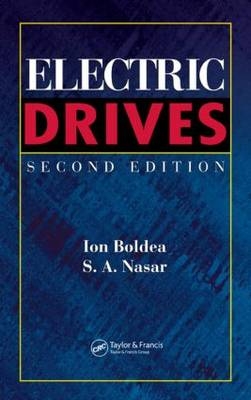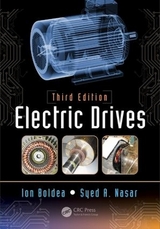
Electric Drives, Second Edition
Crc Press Inc (Verlag)
978-0-8493-4220-2 (ISBN)
- Titel erscheint in neuer Auflage
- Artikel merken
Electric drives are everywhere, and with the looming promise of electric vehicles and renewable energy, they will become more complex and the demands on their capabilities will continue to increase. To keep up with these trends, students require hands-on knowledge and a keen understanding of the subtleties involved in the operation of modern electric drives. The best-selling first edition of Electric Drives provided such an understanding, and this Second Edition offers the same approach with up-to-date coverage of all major types of electric drives, both constant and variable speed.
This book provides a self-contained treatment of low-, medium-, and large-power drives illustrated by numerous application examples, problems, digital simulation results, and test results for both steady state and dynamic operation. This edition features updated material in every chapter, including references; new material on AC brush series motors, capacitor-split inductor motors, single-phase PMSMs and switched reluctance motors, and tooth-wound PMSMs, all with numerical examples; new case studies on AC synchronous and induction motors; and a new chapter on control of electric generators. The companion CD-ROM features the full text, class slides for instructors, and MATLAB® simulations of 10 closed-loop drives, two of which are new to this edition.
With a practical, hands-on approach, Electric Drives, Second Edition is the ideal textbook to help students design, simulate, build, and test modern electric drives, from simple to complex.
ENERGY CONVERSION IN ELECTRIC DRIVES
Electric Drives: A Definition
Application Range of Electric Drives
Energy Savings Pay Off Rapidly
Global Energy Savings Through PEC Drives
Motor/Mechanical Load Match
Motion/Time Profile Match
Load Dynamics and Stability
Multiquadrant Operation
Performance Indexes
Problems
ELECTRIC MOTORS FOR DRIVES
Electric Drives: A Typical Configuration
Electric Motors for Drives
DC Brush Motors
Conventional AC Motors
Power Electronic Converter Dependent Motors
Energy Conversion in Electric Motors/Generators
POWER ELECTRONIC CONVERTERS (PECs) FOR DRIVES
Power Electronic Switches (PESs)
The Line Frequency Diode Rectifier for Constant DC Output Voltage Vd
Line Current Harmonics with Diode Rectifiers
Current Commutation with Id=ct and Ls?0
Three-Phase Diode Rectifiers
Phase-Controlled Rectifiers (AC-DC Converters)
DC-DC Converters (Choppers)
DC-AC Converters (Inverters)
Direct AC-AC Converters
Problems
DC BRUSH MOTORS FOR DRIVES
Basic Topologies
The Motion-Induced Voltage (EMF)
Performance Equations: d-q Model
Steady-State Motor Characteristics
DC Brush Motor Losses
Varying the Speed
Transient Operation for Constant Flux
PM DC Brush Motor Transients
Transient Operation for Variable Flux
Speed/Excitation Voltage Transfer Function
The DC Brush Series Motor
The AC Brush Series Motor
Problems
CONTROLLED RECTIFIER DC BRUSH MOTOR DRIVES
Introduction
Performance Indices
Single PES-Controlled Rectifier
The Single-Phase Semiconverter
The Single-Phase Full Converter
The Three-Phase Semiconverter
The Three-Phase Full Converter Motor Side
The Three-Phase Full Converter: Source-Side Aspects
The Dual Converter: Four-Quadrant Operation
AC Brush Series (Universal) Motor Control
Problems
CHOPPER-CONTROLLED DC BRUSH MOTOR DRIVES
Introduction
The First-Quadrant (Step-Down) Chopper
The Second-Quadrant (Step-Up) Chopper for Generator Braking
The Two-Quadrant Chopper
The Four-Quadrant Chopper
The Input Filter
Digital Simulation Through MATLAB/Simulink
Problems
CLOSED-LOOP MOTION CONTROL IN ELECTRIC DRIVES
Introduction
The Cascaded Motion Control
State-Space Motion Control
Torque Perturbation Observers
Path Tracking
Force Control
Sliding-Mode Motion Control
Motion Control by Fuzzy Systems
Motion Control Through Neural Networks
Neuro-Fuzzy Networks
Problems
INDUCTION MOTORS FOR DRIVES
The Stator and Its Traveling Field
The Cage and Wound Rotors are Equivalent
Slot Shaping Depends on Application and Power Level
The Inductance Matrix
Reducing the Rotor to Stator
The Phase Coordinate Model Goes to 8th Order
The Space-Phasor Model
The Space-Phasor Diagram for Electrical Transients
Electrical Transients with Flux Linkages as Variables
Complex Eigenvalues for Electrical Transients
Electrical Transients for Constant Rotor Flux
Steady-State: It is DC in Synchronous Coordinates
No-Load Ideal Speed May Go Under or Over Conventional Value w1
Motoring, Generating, and AC Braking
DC Braking: Zero Braking Torque at Zero Speed
Speed Control Methods
V1/F1 Torque/Speed Curves
Only for Constant Rotor Flux Torque/Speed Curves are Linear
Constant Stator Flux Torque/Speed Curves Have Two Breakdown Points
The Split-Phase Induction Motor
Problems
PWM INVERTER-FED INDUCTION MOTOR DRIVES
Introduction
Vector Control: General Flux Orientation
General Current Decoupling
Parameter Detuning Effects in Rotor Flux Orientation Current Decoupling
Direct Versus Indirect Vector Current Decoupling
AC versus DC Current Controllers
Voltage Decoupling
Voltage and Current Limitations for the Torque and Speed Control Range
Impressing Voltage and Current Waveforms Through PWM
Indirect Vector AC Current Control: A Case Study
Flux Observers for Direct Vector Control with Motion Sensors
Indirect Vector Synchronous Current Control with Speed Sensor: A Case Study
Flux and Speed Observers in motion Sensorless Drives
Direct Torque and Flux Control (DTFC)
DTFC Sensorless: A Case Study
Feedback Linearized Control
Scalar (V1/F1) Control
Self-Commissioning
Problems
SYNCHRONOUS MOTORS FOR DRIVES
Introduction
Construction Aspects
Pulsating Torque
The Phase Coordinate Model
The Space-Phasor (d-q) Model
Steady-State Operation
To Vary Speed Variable Frequency is Mandatory
Cogging Torque and Tooth-Wound PMSMs
The Single Phase PMSM
Steady State Performance of Single-Phase PMSM
Problems
PM AND RELUCTANCE SYNCHRONOUS MOTOR DRIVES
Introduction
PM-SM Drives: Classifications
Rectangular Current Control (Brushless DC Motor Drives)
Vector (Sinusoidal) Control
Direct Torque and Flux Control (DTFC) of PM-SMs
Sensorless Control of PM-SMs
Reluctance Synchronous Motor (RSM) Drives
High-Frequency (Speed) PMSM Drives
Single-Phase PMSM Control
Problems
SWITCHED RELUCTANCE MOTOR (SRM) DRIVES
Introduction
Construction and Functional Aspects
Average Torque and Energy Conversion Ratio
The Peak kW/kVA Ratio
The Commutation Windings
SRM Modeling
The Flux-Current-Position Curve Fitting
SRM Drives
General Purpose Drive with Position Sensor
High Grade (Servo) Drives
Sensorless SRM Drives
The Voltage-Current Model-Based Position Speed Observer
Single Phase SRM Control
Problems
PRACTICAL ISSUES WITH PWM CONVERTER MOTOR DRIVES
Introduction
The Basic PWM Converter Drive
Line Current Harmonics
Long Motor Power Cables: Voltage Reflection and Attenuation
Motor Model for Ultrahigh Frequency
Common Mode Voltage: Motor Model and Consequences
Common Mode (Leakage) Stator Current Reduction
Circulating Bearing Currents
Reducing the Bearing Currents
Electromagnetic Interference
The Audible Noise
Losses in PWM Converter Drives
Problems
LARGE POWER DRIVES
Power and Speed Limits: Moving Up
Voltage Source Converter Synchronous Motor Drives
Vector Control in Voltage Source Converter SM Drives
Direct Torque and Flux Control (DTFC)
Large Motor Drives: Working Less Time Per Day is Better
Rectifier-Current Source Inverter SM Drives: Basic Scheme
Rectifier-CSI-SM Drive: Steady-State with Load Commutation
Sub- and Hyper-Synchronous IM Cascade Drives
Problems
CONTROL OF ELECTRIC GENERATORS
Introduction
Control of Synchronous Generators in Power Systems
Control of Wound-Rotor Induction Generators (WRIGs) with Limited Speed Range
Autonomous DC Excited Synchronous Generator Control at Variable Speed
Cage-Rotor Induction Generator Control
PM Synchronous Generator Control for Variable Speed
Switched Reluctance Generator (SRG) Control
Each Chapter Also Includes a Summary and Selected References Section
| Erscheint lt. Verlag | 22.8.2005 |
|---|---|
| Zusatzinfo | 13 Tables, black and white; 430 Illustrations, black and white |
| Verlagsort | Bosa Roca |
| Sprache | englisch |
| Maße | 156 x 234 mm |
| Gewicht | 885 g |
| Themenwelt | Technik ► Elektrotechnik / Energietechnik |
| ISBN-10 | 0-8493-4220-1 / 0849342201 |
| ISBN-13 | 978-0-8493-4220-2 / 9780849342202 |
| Zustand | Neuware |
| Haben Sie eine Frage zum Produkt? |
aus dem Bereich



